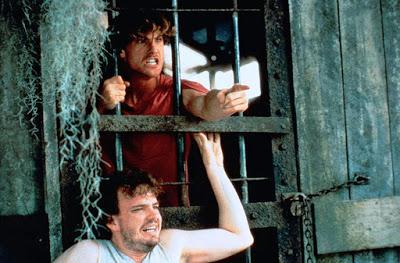 To appreciate the nuanced merits of Shy People, the
viewer would be better advised to know a bit about its Russian director and
story-writer Andrei Konchalovsky.
To appreciate the nuanced merits of Shy People, the
viewer would be better advised to know a bit about its Russian director and
story-writer Andrei Konchalovsky.
First, Konchalovsky is equally renowned as an original scriptwriter as he is as a director. Few are aware that Konchalovsky and Andrei Tarkovsky (who is now accepted worldwide as a cinematic maestro) were classmates in film school. Fewer are aware that three of Tarkovsky’s films (Tarkovsky’s diploma film made for his film school and two later celebrated feature films Andrei Rublyev and Ivan’s Childhood) were coscripted by Konchalovsky. Both these Russian directors are equally well-versed in Christian theology, a fact that most viewers not sufficiently exposed to that aspect will miss out on, in almost all their works. Konchalovsky, more than Tarkovsky, is more exposed and devoted to great writers (playwrights Chekov, Turgenev, Pushkin, Shakespeare and contemporary ones such as Tom Kempinsky, and novelist Dostoyevsky) and scripts and writings of the Japanese master filmmaker Akira Kurosawa (The Runaway Train) as is evident from his cinematic and dramatic output.His interests and knowledge are staggering—music, sociology, politics, to mention a few but often Russia-centric.

Drugs and sex: the young girl from Manhattan, Grace (Martha Plimpton) woos
her "jailed" cousin Tommy (John Philbin)
There are three phases in his career—his pre-US output in film and theater within Russia, his short-lived US career, and his current post-US work on his return to his native land. By any evaluation, his career in USA had its highs and its lows. Shy People is one of the three remarkable films made in this period, the other two being The Runaway Train and Maria’s Lovers. The weaker works of this period included the film version of Kempinsky’s play Duet for One, Homer and Eddie and the very commercial Tango and Cash (which Konchalovsky did not write but merely co-directed under intense interference by studio executives). A major contributing factor for the low popularity of Shy People was the demise of the Cannon film company, which coincided with that film’s completion and release. Shy People, after winning the Best Actress Award at Cannes, suffered a limited release within USA and no Oscar nomination. This is in sharp contrast with the success of The Runaway Train (a film that won a Golden Globe for Jon Voight as Best Actor and three Oscar nominations, and a nomination at Cannes), Duet for One (a Golden Globe nomination for actress Julie Andrews), and Homer and Eddie (winner of the best film award at the San Sebastian International Film festival). Thus even the bad films of the uneven US period actually resulted in critical recognition, with the exception of Tango and Cash.
The post-US phase that began in 1991 has resulted in higher international acclaim for Konchalovsky.Two of his films in this phase (The Postman’s White Nights and Paradise) have won the Best Director award and a third (House of Fools) a Grand Jury Prize at the Venice film festival.

A prison within a house, created by a mother for a son Tommy (John Philbin),
while his mentally challenged brother Paul (Pruitt Taylor Vince) is free to roam
Thus, Shy People, which was to be his final film of his US phase, uncannily anticipates his eventual return to Russia, because there are several elements in the film that are very Russian for a keen observer. What is Russian in Shy People, one might ask? If you knew the basic information on the director and a little bit of Stalin’s Russia, the huge portrait in the living room of the Sullivans has an unmistakable resemblance to Joseph Stalin. Joseph and Joe (the film’s character) are other hints. The fictional character of Joe closely resembles the famed brutality of the Russian dictator. The isolation of the fictional Louisiana family in the bayou devoid of friends and technological progress complete with a prison within the compound of the house would bring back memories of Stalinist Soviet Union with its penal colonies in Serbia. A Konchalovsky devotee who has seen his much later work The Postman’s White Nights (2014) made in the post-Stalinist, post-Glasnost Russia that reprises the lonely and sometimes scary boat rides of the Louisiana bayou after a 30-year gap will wonder at how his mind was focused on life in his homeland while he filmed in USA and how he transposes the filmed imagery in USA to modern Russia. The basic statement in both films remain the same—some people live in a time warp removed from scientific progress rubbing shoulders with good people and bad people, essentially carbon copies in both countries. Both films give a lot of importance to memories, metaphorically presented as photographs of the past—the 2014 film begins with such a sequence, while Shy People includes it in the middle. In Shy People there are townsfolk in smaller US towns living in awe of color TV programs, while in The Postman’s White Nights there are isolated rural communities, the inhabitants of which are ironically penalized for fishing in their nearby waterbodies while influential military personnel can do that without restraint and Russia continues to send vehicles into space in a facility not far removed from them.

Barabara Hershey as Ruth (left) and Jill Clayburgh as Diana (right) are cousins
meeting for the first time. The jewelry, hats, clothes and demenor are
contrasting. Looking on is Ruth's mentally challenged son Paul (Vince).
Shy People is a lovely essay on family relationships contrasting the stronger binding forces in rural, isolated communities to the weaker, cosmopolitan urban communities—here Louisiana’s bayou versus the freedom of the upper crust living in Manhattan in New York. Two mothers are contrasted from the two different represented geographies, both dealing with wayward offspring.One mother is religious and indirectly quotes a passage from the Bible’s book of Revelations on being “lukewarm and not being hot or cold.” There is no mention of religion in the spoken passage, but the director is able put it in context by adding the end-quote at the end of the film, soon after the urban mother decides to be “hot” about influencing her wayward, intelligent daughter on the flight back home.

“I know thy work, and thou art neither cold nor hot; I would thou wert cold or hot. So then because thou art lukewarm, and neither cold nor hot, I will spew thee out of my mouth” Revelations 3: 15-16The choice of names by scriptwriter Konchalovsky seems to be deliberate and alludes to Biblical characters, e.g., Ruth in the film and the Bible, while Diana is very Greek and non-Biblical. The three sons of Ruth have Biblical names. Both Tarkovsky and Konchalovsky reflect their spiritual beliefs in their films, often deliberately.
For those who are familiar with Russian films, the importance of the bonding between mother and her offspring recurs with poetic flourish in Aleksandr Sokurov’s masterpiece Mother and Son (1997) and way back in the silent era with Vsevolod Pudovkin’s Mother (1926). Sokurov explored connected subjects—grandmother and grandson in Aleksandra (2007) and father in son in Father and Son (2003). A recent Cannes award-winning film Closeness (2017) deals with the reverse—the bonding between a daughter and her parents.
A casual viewer of Shy People is likely to dismiss the film for being unrealistic—which it is, in some ways. Can a writer of Cosmopolitan magazine throw her weight around in a small town in Louisiana and influence the local police? Can a woman injure a man in public with a gun wound and get away with it? Is it a ghost story or is it not?
Repeated viewings of the film will reveal the depths of the film and magical combination of inspired acting (Barbara Hershey and Jill Clayburgh, in particular), the cinematography of Chris Menges, the art direction/production design of Leslie McDonald, the music of Tangerine Dream, and the director’s script. This is a masterpiece of American cinema, crying to be discovered and acknowledged as such and definitely a Konchalovsky gem ranking alongside his The Runaway Train made two years earlier.
.
P.S. Shy People is one of the author’s top 100 films. It won the best actress award for Barbara Hershey at the Cannes Film Festival. Several films mentioned in the above review, the US film The Runaway Train (1985) and the Russian films The Postman’s White Nights (2014) and Paradise (2016) have been reviewed earlier on this blog. (Click on the name of the film in this post-script for a quick access to those reviews on this blog.) Thankfully, the film has been uploaded on Youtube by a kind soul making it available for wider viewing.

